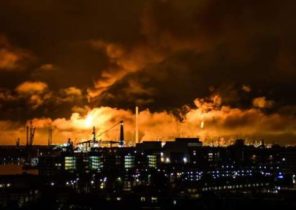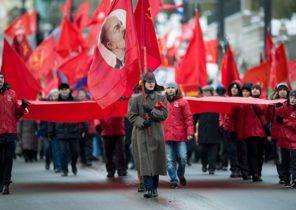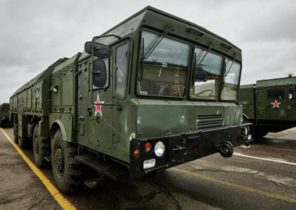Once on a spring day in 2019 Alexander Kizyakov down on a rope 60-foot wall Batagayskogo fault in Eastern Siberia. He did stop collecting clods of soil ice, which has frozen many centuries ago. “One of my Hobbies is rock climbing,” says Dung, who are engaged in research of permafrost in the Moscow state University named after Lomonosov (MGU). His colleagues had collected at the bottom of the cliff, samples of the most ancient soil. Summer to carry out such work was dangerous because the ice is melting with a Bang, and the wall of the fault down break down huge chunks of permafrost, sometimes the size of a car.
The locals called the break “a door to the underworld”. In fact, everything is more prosaic: Batagayskogo crater is the largest on our planet, the collapse of the soil. It was only a small gully in the slope, which in the 1960s were the years of logging. But the scar of nature from year to year, as the permafrost melts, and melt water carry away the soil. Now the width of the fracture is more than 900 meters, and it has become a clear example of how vulnerable permafrost in the Arctic, where temperatures in the last 30 years is growing two times faster than the world average.
But the rift is also a message from the past, excites the curiosity of scientists in the soil samples, which are like a snapshot of ancient climate which existed hundreds of thousands of years ago ecosystems. “This is a breathtaking place,” says paleoclimatologist Thomas Opel (Opel Thomas) from the Alfred Wegener Institute. Samples of ice and soil, collected in Batagayskogo the crater, indicate that there is the oldest in Eurasia open the permafrost, which in some places reaches 650 000 years. This Opel colleagues said in may at a General meeting of the European Union’s scientific disciplines about the study of the Earth. This material has so much to tell you about the permafrost and surface vegetation responded to past climate warming. “It gives us a glimpse into the days when the permafrost was stable, and in those days, when it was destroyed,” says Opel.
Global warming causes wounds all over Siberia. Emissions of underground methane from melting permafrost is dotted with deserted areas on the peninsulas of Yamal and Gydan craters with a diameter of tens of meters. On floating soil cracked and destroyed houses that annually causes the Russian economy to the detriment of two billion dollars. Forest fires over the last three summers have destroyed millions of hectares of the taiga. Suffers Siberia: after the fires remain dark soot and charcoal. And they absorb heat and accelerate melting and negatively affect the entire region.
The current fires have exacerbated the heat, ipaalala Siberia in the first half of the summer. On June 20 the temperature in Verkhoyansk, which is located in 75 kilometers from Batagay and is one of the coldest inhabited places on Earth, has reached 38 degrees Celsius. It was the highest temperature recorded in the Arctic. “This record-breaking heat wave would have been impossible without the negative role of the person whose activity causes climate change,” said the authors published in the 15 July report, which was written based on the results of a study conducted by a team of meteorologists from the Association World Weather Attribution. These researchers analyze the potential impact of climate change on weather anomalies.
The enduring question is how much carbon the thawing soil will release into the atmosphere, and whether the Arctic vegetation is becoming more lush in terms of warming, to absorb enough carbon dioxide to offset the emissions. Maybe the Arctic has already reached the point of no return. Judging by the results of observations on 100 field stations of the Northern permafrost, in the period from 2003 to 2017 annually throw away 600 million tonnes of carbon more than it can consume this vegetation. This conclusion was made by scientists in October 2019.
Researchers travel annually to the area Batagayskogo fault, trying to figure out what he has to say about it. The trips, organized by the Yakut scientific research Institute of applied ecology of the North, not for the faint of heart. In 2014, Ksenia passed Achatina two miles to the marshy and mosquito-infested woods to reach the edge of the rift. “When we approach the fault, often hear the crackling and clicking. Suddenly discovering that the trees ran out, and you’re standing on the overhanging ledge of the slope,” says Agustina working paleobotanical Institute of science max Planck. She and her colleagues from the Senckenberg research Institute and natural history Museum lived together with the indigenous Siberians, Evenki, and Yakuts. Some aboriginal people are afraid of the giant fault. “They say that the crater eats up the ground, swallowing trees and their Holy places,” — says Agustina.
To know the age of the exposed permafrost, the team of Opel uses fluorescent method of Dating that shows when the minerals in the soil last saw the light of day. They also apply the new method of Russian Dating chlorine in the ice. This allows them to relate soil layers with known climatic periods in the past. And are in abundance in the ice isotopes oxygen-18 and deuterium are indicative of what these places had a temperature. The composition of the soil in the area of Batagay also allows you to understand how much carbon has accumulated permafrost for millennia.
Permafrost also gives the opportunity to look at ancient Arctic ecosystem. Collecting samples of plant remains, the scientists found that during the last ice age, when winter temperatures dropped lower than in the modern era, the vegetation was surprisingly lush and abundant, the service of food for woolly mammoths, rhinoceroses and other extinct herbivores that grazed in the meadow steppe ecosystem. “It was a Paradise for producing animal feed,” says Agustina.
Sometimes the remains of these extinct creatures fall out directly from the slope of the fault in excellent condition. In 2018, scientists have discovered the remains of a young Lena horse (Equus lenensis) reddish color, which is an extinct relative of the Yakut horse. Soft tissue she has survived without damage. Scientists hope to find a living cell to clone this foal, which is 42,000 years old. Some preserved muscle tissue inspire much hope, says molecular biologist P. Olof Olson (P. Olof Olsson) from the Fund biotechnological research in Abu Dhabi, which joined forces in these studies, North-Eastern Federal University of Yakutsk. “I’m a skeptical optimist, says Olson. — At least in principle, such cloning is possible.”
Since the element more Batagayskogo deepens the rift and scientists can go much further in time. Advancing glaciers carry with them the soil, but they Siberia in the last ice age has been largely avoided, whereby the thickness of the permafrost in some areas reaches hundreds of meters. Warm summers for decades turns into muck soil with a large content of ice, and the wall Batagayskogo rift is growing by 10 meters, says the researcher of the permafrost Frank günter (Frank Guenther) from Potsdam University. According to him, in 2016 it increases to 12-14 meters per year. It is difficult to accurately determine how quickly deepens the rift and, consequently, how far in time penetrated the melting. The most ancient permafrost, whose age has been determined (it is in the Yukon territory in Canada), 740 000 years. Climatologists may not like it, but if the summer in Siberia will continue to be as hot Batagayskogo maharasan can set another record.







